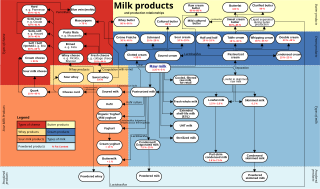
Dairy products or milk products, also known as lacticinia, are food products made from milk. The most common dairy animals are cow, water buffalo, nanny goat, and ewe. Dairy products include common grocery store food items in the Western world such as yogurt, cheese, milk and butter. A facility that produces dairy products is known as a dairy. Dairy products are consumed worldwide to varying degrees. Some people avoid some or all dairy products either because of lactose intolerance, veganism, or other health reasons or beliefs.

Halloumi or haloumi is a cheese of Cypriot origin made from a mixture of goat's and sheep's milk, and sometimes also cow's milk. Its texture is described as squeaky. It has a high melting point and so can easily be fried or grilled, a property that makes it a popular meat substitute. Rennet is used to curdle the milk in halloumi production, although no acid-producing bacteria are used in its preparation.
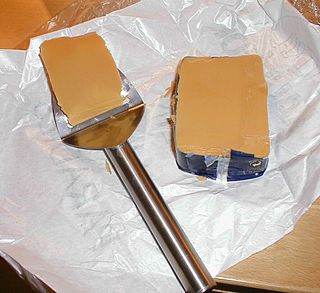
Brunost is a common Norwegian name for mysost, a family of cheese-related foods made with whey, milk, and/or cream. The term is often used to refer to Fløtemysost or Gudbrandsdalsost, which are the most popular varieties. Brunost is primarily produced in Norway and is popular there, and has spread to South Korea. It is regarded as one of the country's most iconic foodstuffs, and is considered an important part of Norwegian gastronomical and cultural identity and heritage.

Goat cheese, goat's cheese, or chèvre is cheese made from goat's milk. Goats were among the first animals to be domesticated for producing food. Goat cheese is made around the world with a variety of recipes, giving many different styles of cheeses, from fresh and soft to aged and hard.
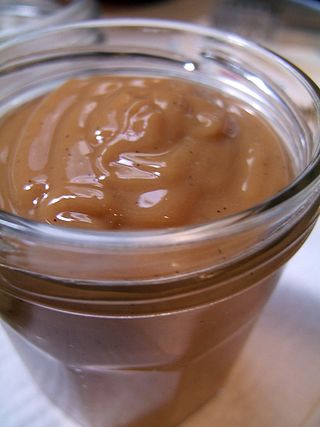
Dulce de leche, is a confection popular in Latin America prepared by slowly heating sugar and milk over a period of several hours. The resulting substance, which takes on a spreadable, sauce-like consistency, derives its rich flavour and colour from non-enzymatic browning. It is typically used to top or fill other sweet foods.
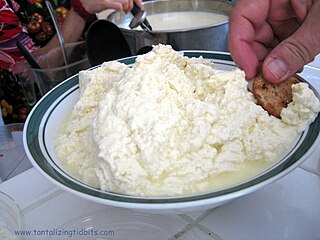
Ricotta is an Italian whey cheese made from sheep, cow, goat, or Italian water buffalo milk whey left over from the production of other cheeses. Like other whey cheeses, it is made by coagulating the proteins that remain after the casein has been used to make cheese, notably albumin and globulin.

Cheesemaking is the craft of making cheese. The production of cheese, like many other food preservation processes, allows the nutritional and economic value of a food material, in this case milk, to be preserved in concentrated form. Cheesemaking allows the production of the cheese with diverse flavors and consistencies.

Gamalost is a traditional Norwegian cheese.

Storsteinnes is the administrative center of Balsfjord Municipality in Troms og Finnmark county, Norway. The 1.1-square-kilometre (270-acre) village has a population (2017) of 1,076 which gives the village a population density of 978 inhabitants per square kilometre (2,530/sq mi). This makes it the largest urban area in the municipality. Storsteinnes Chapel is located in this village.
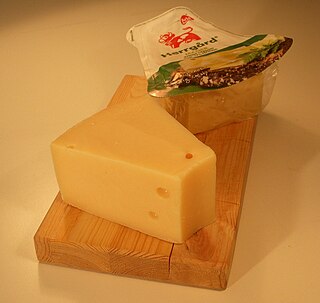
Herrgårdsost is a semi-hard Swedish cheese made from cow's milk. The aged cheese has a mild, nutty and creamy taste. The cheese has small round holes and a waxed surface. Herrgårdsost is usually manufactured in wheels about 40 cm (16 in) in diameter and 12 cm (4.7 in) wide, weighing around 14 kg (31 lb).
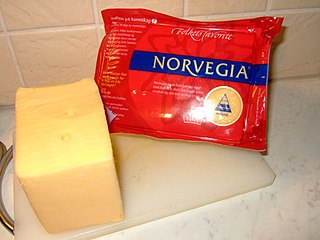
Norvegia is a Norwegian cow's milk cheese produced by Tine. It has a market share of about 60% of white cheeses in Norway. It is Norway's best-selling cheese. It is similar to Gouda, has a mild taste and melts easily. There are different types of it. It has been produced since the 1890s. Its recipe details remain a trade secret of Tine.

Cheese is a dairy product produced in wide ranges of flavors, textures, and forms by coagulation of the milk protein casein. It comprises proteins and fat from milk. During production, milk is usually acidified and either the enzymes of rennet or bacterial enzymes with similar activity are added to cause the casein to coagulate. The solid curds are then separated from the liquid whey and pressed into finished cheese. Some cheeses have aromatic molds on the rind, the outer layer, or throughout.

Caprino is an Italian cheese traditionally made from whole or skimmed goat's milk. The name of the cheese derives from the Italian word for goat, capra. With modern methods of production, the cheese is made from cow's milk as well or a combination of both cow's and goat's milks. The two major styles of caprino are fresco (fresh) and stagionato (aged).
Fløtemysost or Fløytemysost is a type of brunost or brown cheese made from cow's milk.

There are many different types of cheese. Cheeses can be grouped or classified according to criteria such as length of fermentation, texture, methods of production, fat content, animal milk, and country or region of origin. The method most commonly and traditionally used is based on moisture content, which is then further narrowed down by fat content and curing or ripening methods. The criteria may either be used singly or in combination, with no single method being universally used.

Whey cheese is a dairy product made of whey, the by-product of cheesemaking. After the production of most cheeses, about 50% of milk solids remain in the whey, including most of the lactose and lactalbumin. The production of whey cheese allows cheesemakers to use the remaining whey, instead of discarding it as a waste product.

Anne Hov was a Norwegian farm wife from Gudbrandsdalen. She has been credited with developing the modern version of the cheese brunost.
















